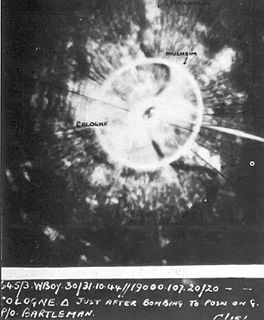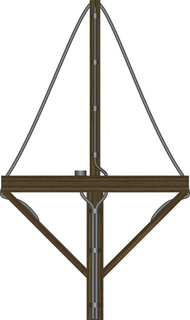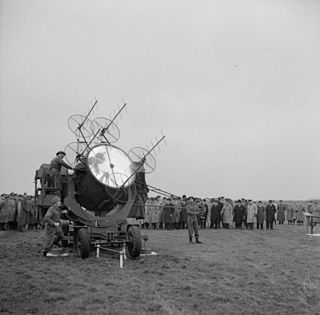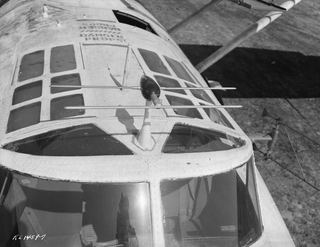
A night fighter is a fighter aircraft adapted for use at night or in other times of bad visibility. Night fighters began to be used in World War I and included types that were specifically modified to operate at night.

The Leigh Light (L/L) was a British World War II era anti-submarine device used in the Battle of the Atlantic. It was a powerful carbon arc searchlight of 24 inches (610 mm) diameter fitted to a number of the British Royal Air Force's Coastal Command patrol bombers to help them spot surfaced German U-boats at night.

H2S was the first airborne, ground scanning radar system. It was developed for the Royal Air Force's Bomber Command during World War II to identify targets on the ground for night and all-weather bombing. This allowed attacks outside the range of the various radio navigation aids like Gee or Oboe, which were limited to about 350 kilometres (220 mi). It was also widely used as a general navigation system, allowing landmarks to be identified at long range.
Serrate was a World War II Allied radar detection and homing device used by night fighters to track Luftwaffe night fighters equipped with the earlier UHF-band BC and C-1 versions of the Lichtenstein radar. It allowed RAF night fighters to attack their German counterparts, disrupting their attempts to attack the RAF's bomber force.

The R600A Metox, named after its manufacturer, was a pioneering high-frequency radar warning receiver (RWR) manufactured by a small French company in occupied Paris. It was tuned to receive the 1.5-metre (200 MHz) signals used by many British radars of the early and mid-World War II era, notably the ASV Mk. II radar used by RAF Coastal Command to attack U-boats. It is not clear whether the design was German or French or both. It was installed on German U-boats starting in 1942 and used until the end of the war. The system given the official title of FuMB 1.

The Mid-Atlantic gap is a geographical term applied to an undefended area beyond the reach of land-based RAF Coastal Command antisubmarine (A/S) aircraft during the Battle of the Atlantic in the Second World War. It is frequently known as The Black Pit, as well as the Atlantic Gap, Air Gap, Greenland Gap, or just "the Gap". This resulted in heavy merchant shipping losses to U-boats. The gap was eventually closed in May 1943, as growing numbers of VLR Liberators and escort carriers became available, and as basing problems were addressed.
Radar in World War II greatly influenced many important aspects of the conflict. This revolutionary new technology of radio-based detection and tracking was used by both the Allies and Axis powers in World War II, which had evolved independently in a number of nations during the mid 1930s. At the outbreak of war in September 1939, both Great Britain and Germany had functioning radar systems. In Great Britain, it was called RDF, Range and Direction Finding, while in Germany the name Funkmeß (radio-measuring) was used, with apparatuses called Funkmessgerät . By the time of the Battle of Britain in mid-1940, the Royal Air Force (RAF) had fully integrated RDF as part of the national air defence.

The FuG 240 "Berlin" was an airborne interception radar system operating at the "lowest end" of the SHF radio band, which the German Luftwaffe introduced at the very end of World War II. It was the first German radar to be based on the cavity magnetron, which eliminated the need for the large multiple dipole-based antenna arrays seen on earlier radars, thereby greatly increasing the performance of the night fighters. Introduced by Telefunken in April 1945, only about 25 units saw service.

Radar, Airborne Interception, Mark IV, produced by USA as SCR-540, was the world's first operational air-to-air radar system. Early Mk. III units appeared in July 1940 on converted Bristol Blenheim light bombers, while the definitive Mk. IV reached widespread availability on the Bristol Beaufighter heavy fighter by early 1941. On the Beaufighter, the Mk. IV arguably played a role in ending the Blitz, the Luftwaffe's night bombing campaign of late 1940 and early 1941.

Radar, Airborne Interception, Mark VIII, or AI Mk. VIII for short, was the first operational microwave-frequency air-to-air radar. It was used by Royal Air Force night fighters from late 1941 until the end of World War II. The basic concept, using a moving parabolic antenna to search for targets and track them accurately, remained in use by most airborne radars well into the 1980s.

Airborne Interception radar, or AI for short, is the British term for radar systems used to equip aircraft in air-to-air role. These radars are used primarily by Royal Air Force (RAF) and Fleet Air Arm night fighters and interceptors for locating and tracking other aircraft, although most AI radars could also be used in a number of secondary roles as well. The term was sometimes used generically for similar radars used in other countries.
German Luftwaffe and Navy Kriegsmarine Radar Equipment during World War II, relied on an increasingly diverse array of communications, IFF and RDF equipment for its function. Most of this equipment received the generic prefix FuG, meaning "radio equipment". During the war, Germany renumbered their radars. From using the year of introduction as their number they moved to a different numbering scheme.

The Type 277 was a surface search and secondary aircraft early warning radar used by the Royal Navy and allies during World War II and the post-war era. It was a major update of the earlier Type 271 radar, offering much more power, better signal processing, new displays, and new antennas with greatly improved performance and much simpler mounting requirements. It allowed a radar with performance formerly found only on cruisers and battleships to be fitted even to the smallest corvettes. It began to replace the 271 in 1943 and was widespread by the end of the year.

Searchlight Control, SLC for short but nicknamed "Elsie", was a British Army VHF-band radar system that provided aiming guidance to an attached searchlight. By combining a searchlight with a radar, the radar did not have to be particularly accurate, it only had to be good enough to get the searchlight beam on the target. Once the target was lit, normal optical instruments could be used to guide the associated anti-aircraft artillery. This allowed the radar to be much smaller, simpler and less expensive than a system with enough accuracy to directly aim the guns, like the large and complex GL Mk. II radar. In 1943 the system was officially designated Radar, AA, No. 2, although this name is rarely used.

Radar, Air-to-Surface Vessel, Mark II, or ASV Mk. II for short, was an airborne sea-surface search radar developed by the UK's Air Ministry immediately prior to the start of World War II. It was the first aircraft mounted radar of any sort to be used operationally. It was widely used by aircraft of the RAF Coastal Command, Fleet Air Arm and similar groups in the United States and Canada. A version was also developed for small ships, the Royal Navy's Type 286.
Radar, Air-to-Surface Vessel, or ASV radar for short, is a classification used by the Royal Air Force (RAF) to refer to a series of aircraft-mounted radar systems used to scan the surface of the ocean to locate ships and surfaced submarines. The first examples were developed just before the opening of World War II and they have remained a major instrument on patrol aircraft since that time. It is part of the wider surface search radar classification, which includes similar radars in ground and ship mountings.

Radar, Air-to-Surface Vessel, Mark III, or ASV Mk. III for short, was a surface search radar system used by RAF Coastal Command during World War II. It was a slightly modified version of the H2S radar used by RAF Bomber Command, with minor changes to the antenna to make it more useful for the anti-submarine role. It was Coastal Command's primary radar from the spring of 1943 until the end of the war. Several improved versions were introduced, notably the ASV Mark VI, which replaced most Mk. IIIs from 1944 and ASV Mark VII radar, which saw only limited use until the post-war era.

The SCR-720 was a World War II Airborne Interception radar designed by the Radiation Laboratory (RadLab) at MIT in the United States. It was used by US Army Air Force night fighters as well as the Royal Air Force (RAF) in a slightly modified version known as Radar, Airborne Interception, Mark X, or AI Mk. X for short.













